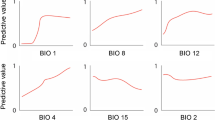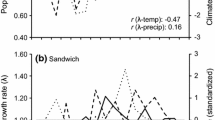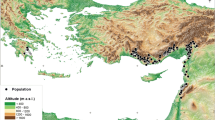Abstract
The Chinese Bulbul (Pycnontus sinensis) has an extensive distribution throughout southern China. Investigators have reported that the species has expanded its distribution range northward since 1995. We performed a literature review and analysis to examine the relationships between the range expansion of the species and the changes of climate and habitat. We found that the northward range expansion was associated with the increased temperature and human created habitat. We believe that the combination of the increased temperature and the ability to utilize human created habitat while maintaining genetic diversity resulted in the population increase and range expansion of the species. We suggest that increased temperature and human disturbance could lead to evolutionary and distributional changes of some species such as the Chinese Bulbul, therefore possibly making these species indicators of climate change.
Similar content being viewed by others
References
Bermúdez-Cuamatzin E., Ríos-Chelén A.A., Gil D. & Garcia C.M. 2011. Experimental evidence for real-time song frequency shift in response to urban noise in a passerine bird. Biol. Lett. 7: 36–38. DOI: 10.1098/rsbl.2010.0437
Both C. & Visser M.E. 2001. Adjustment to climate change is constrained by arrival date in a long-distance migrant bird. Nature 411: 296–298. DOI: 10.1038/35077063
Brommer J.E. 2004. The range margins of northern birds shift polewards. Ann. Zool. Fenn. 41(2): 391–397.
Brommer J.E. & Møller A.P. 2010. Rangemargins, climate change and ecology, Section 4, chapter 17, pp. 275–294. In: Møller A.P., Fiedler W. & Berthold P. (eds), Effects of Climate Change on Birds. Oxford Univ. Press, Oxford, 344 pp. ISBN: 9780199569748, 9780199569755
Burger J. 1981. The effect of human activity on birds at a coastal bay. Biol. Conserv. 21(3): 231–241. DOI: 10.1016/0006-3207(81)90092-6
Butler C.J. 2003. The disproportionate effect of global warming on the arrival dates of short-distance migratory birds in North America. Ibis 145(3): 484–495. DOI: 10.1046/j.1474-919X.2003.00193.x
Crick H.Q.P. & Sparks T.H. 1999. Climate change related to egg-laying trends. Nature 399(6735): 423–424. DOI: 10.1038/20839
Davidson E.A. & Janssens I.A. 2006. Temperature sensitivity of soil carbon decomposition and feedbacks to climate change. Nature 440(7081): 165–173. DOI: 10.1038/nature04514
Du K. & Ma J.F. 2011. Four new records of birds in Ningxia. Chin. J. Agricult. Sci. 32(2): 95–96.
Dunn P.O. & Winker D.W. 1999. Climate change has affected the breeding date of tree swallows throughout North America. Proc. Roy. Soc. B Biol. 266(1437): 2487–2490. DOI: 10.1098/rspb.1999.0950
Fiedler W. 2003. Recent changes in migratory behaviour of birds: A compilation of field observations and ringing data, pp. 21–38. DOI: 10.1007/978-3-662-05957-9 2. In: Berthold P., Gwinner E. & Sonnenschein E (eds), Avian Migration, Springer, Berlin, Germany, 610 pp. ISBN: 978-3-642-07780-7
Gao M. 2006. [New records of birds — Rafous Fantail Wabler in Northeast]. Sichuan J. Zool. 25(4): 890. [in Chinese]
Gong H.S., Gao X.B. & Li J.Q. 2007. [Two new records of birds in Shannxi Province]. Chin. J. Zool. 42(4): 146. [in Chinese]
Han F.R. & Zhou T.L. 2005. A research into the propagation ecology of Carduelis sinica and Pycnonotus sinensis. Journal of Longdong University (Natural Science Edition) 15(2): 42–45.
Hitch A.T. & Leberg P.L. 2007. Breeding distributions of North American bird species moving north as a result of climate change. Conserv. Biol. 21(2): 534–539. DOI: 10.1111/j.1523-1739.2006.00609.x
Hoffman A.A. & Parsons P.A. 1997. Extreme Environmental Change and Evolution. Cambridge University Press, Cambridge, 272 pp. ISBN: 9780521446594
Hulme M. 2010. Why We Disagree About Climate Change. Cambridge University Press, Cambridge, 392 pp. ISBN: 979-0-521-98869-0
Huntley B., Collinggham Y.C. & Green R.E. 2006. Potential impacts of climatic change upon geographical distributions of birds. Ibis 148(Suppl s1): 8–28. DOI: 10.1111/j.1474-919X.2006.00523.x
Jean-Marc T. 2006. Large bird declines with increasing human pressure in savanna woodlands (Burkina Faso). Biodivers. Conserv. 15(7): 2085–2108. DOI: 10.1007/s10531-004-6684-3
Knudsen E., Lindén A., Both C., Jonzen N., Pulido F., Saino N., Sutherland W., Bach L., Coppack T., Ergon T., Gienapp P., Gill J., Gordo O., Hedenström A., Lehikoinen E., Marra P., Møller A.P., Nilsson A., Péron G., Ranta E., Rubolini D., Sparks T.H., Spina F., Studds C., Sæher S., Tryjanowski P. & Stenseth N.C. 2011. Challenging claims in the study of migratory birds and climate change. Biol. Rev. 86(4): 928–946. DOI: 10.1111/j.1469-185X.2011.00179.x
La Sorte F.A. & Thompson F.R.III. 2007. Poleward shifts in winter ranges of North American birds. Ecology 88(7): 1803–1812. DOI: 10.1890/06-1072.1 ISSN:00129658
Li D.L., Ding Z.J., Yin J.X. & Wan D.M. 2013. [Chinese Bulbul (Pycnonotus sinensis) has further north expand to Shenyang, China]. Chin. J. Zool. 48(1): 74. [in Chinese]
Li D.M., Wang A.Z. & Lei F.M. 2006. [New bird record — Chinese Bulbul (Pycnonotus sinensis) found in Qinghai Province, China]. Chin. J. Zool. 41(4): 70. [in Chinese]
Luo J., Wang Y., Huang Z., Feng Z. & Feng Y. 2006. [A new record of bird, Sturnus nigricollis, in Chongqing]. Sichuan J. Zool. 25(4): 862. [in Chinese]
MacMynowski D.P., Root T.L., Ballard G. & Geupel G.R. 2007. Changes in spring arrival of Nearctic-Neotropical migrants attributed to multiscalar climate. Global Change Biol. 13(11): 2239–2251. DOI: 10.1111/j.1365-2486.2007.01448.x
Martin T.E. & Maron J.L. 2012. Climate impacts on bird and plant communities from altered animal-plant interactions. Nature Climate Change 2: 195–200. DOI: 10.1038/nclimate1348
Mccarthy J.J., Canziani O.F., Leary N.A., David J. D. & Kasey S. W. (eds) 2001. Climate Change: Impacts, Adaptation and Vulnerability. Cambridge University Press, Cambridge, 1032 pp. ISBN: 0 521 80768 9
Milly P.C.D., Dunne K.A. & Vecchia A.V. 2005. Global pattern of trends in streamflow and water availability in a changing climate. Nature 438: 347–350. DOI: 10.1038/nature04312
Møller A.P., Fiedler W. & Berthold P. (eds) 2004. Birds and Climate Change. Advances in Ecological Research. Vol. 35. Elsevier Academic Press, London, 259 pp. ISBN: 0-12-013-935-9
Murphy-Klassen H.M., Underwood T.J., Sealy S.G. & Czyrnyj A.A. 2005. Long-term trends in spring arrival dates of migrant birds at Delta Marsh, Manitoba, in relation to climate change. Auk 122: 1130–1148. DOI: 10.1642/0004-8038(2005)122[1130:LTISAD]2.0.CO;2
Newton I. 2008. The Migration Ecology of Birds. Academic Press, London, 976 pp. ISBN: 0125173679, 9780125173674
Parmesan C. 2006. Ecological and evolutionary responses to recent climate change. Annu. Rev. Ecol. Evol. Syst. 37: 637–669. DOI: 10.1146/annurev.ecolsys.37.091305.110100
Parmesan C. & Yohe G. 2003. A globally coherent fingerprint of climate change impacts across natural systems. Nature 421(6918): 37–42. DOI: 10.1038/nature01286
Peh K.S.H. 2007. Potential effects of climate change on elevational distributions of tropical birds in Southeast Asia. Condor 109: 437–441. DOI: http://dx.doi.org/10.1650/0010-5422(2007)109[437:PEOCCO]2.0.CO;2
Pounds J.A., Fogden M.P.L. & Campbell J.H. 1999. Biological response to climate change on a tropical mountain. Nature 398(6728): 611–615. DOI: 10.1038/19297
Reino L., Moya-Larańo J. & Cláudio Heitor A. 2009. Using survival regression to study patterns of expansion of invasive species: will the common waxbill expand with global warming? Ecography 32(2): 237–246. DOI: 10.1111/j.1600-0587.2008.05354.x
Robinet C. & Roques A. 2010. Direct impacts of recent climate warming on insect populations. Integr. Zool. 5(2): 132–142. DOI: 10.1111/j.1749-4877.2010.00196.x
Root T.L., MacMynowski D.P., Mastrandrea M.D. & Schneider S.H. 2005. Human modified temperatures induce species changes:joint attribution. Proc. Natl Acad. Sci. USA 102(21): 7465–7469. DOI: 10.1073/pnas.0502286102
Rosenzweig C., Karoly D., Vicarelli M., Neofotis P., Wu Q., Casassa G., Menzel A., Root T.L., Estrella N., Seguin B., Tryjanowski P., Liu C., Rawlins S. & Imeson A. 2008. Attributing physical and biological impacts to anthropogenic climate change. Nature 453(7193): 353–358. DOI: 10.1038/nature06937
Song G., Yu L.J., Gao B., Zhang R.Y., Qu Y.H., Lambert D.M., Li S.H., Zhou T.L. & Lei F.M. 2013. Gene flow maintains genetic diversity and colonization potential in recently rangeexpanded populations of an Oriental bird, the Light-vented Bulbul (Pycnonotus sinensis, Aves: Pycnonotidae). Divers. Distrib. 19(10): 1248–1262. DOI: 10.1111/ddi.12067
Stephen N., Matthews L.R., Iverson A.M.P. & Matthew P.P. 2011. Changes in potential habitat of 147 North American breeding bird species in response to redistribution of trees and climate following predicted climate change. Ecography 34(6): 933–945. DOI: 10.1111/j.1600-0587.2011.06803.x
Thomas C.D., Cameron A., Green R.E., Bakkenes M., Beaumont L.J., Collingham Y.C. & Williams S.E. 2004. Extinction risk from climate change. Nature 427(6970): 145–148. DOI: 10.1038/nature02121
Thomas C.D. & Lennon J.J. 1999. Birds extend their ranges north-wards. Nature 399(6733): 213. DOI: 10.1038/20335
Tryjanowski P. & Sparks T.H. 2001. Is the detection of the first arrival date of migrating birds influenced by population size? A case study of the Red-backed Shrike Lanius collurio. Int. J. Biometeorol. 45(4): 217–219. DOI: 10.1007/s00484-001-0112-0
Walther G.R. 2004. Plants in a warmer world. Perspectives in Plant Ecology, Evolution and Systematics 6(3): 169–185. DOI: 10.1078/1433-8319-00076
Walther G.R., Postm E. & Convey P. 2002. Ecological responses to recent climate change. Nature 416(6879): 389–395. DOI: 10.1038/416389a
Wang X.P., Du M., Sun L.X. & Li J.L. 2005. New distribution of Chinese Bulbul (Pycnonotus sinensis) in Lüshun of Dalian, China. Zool. Res. 26(1): 95.
Wang Y., Zhang Z.W., Zheng G.M. & Li J.Q. 2012. Ornithological research: past twenty years and future perspectives in China. Biodivers. Sci. 20(2): 119–137. DOI: 10.3724/SP.J.1003.2012.19175
Woodward F.I. 1987. Climate and Plant Distribution. Cambridge University Press, Cambridge, 188 pp. ISBN: 9780521282147
Wu P., Wood R. & Stott P. 2005. Human influence on increasing Arctic river discharges. Geophys. Res. Lett. 32(2): L02703. DOI: 10.1029/2004GL021570
Wu Y.H. & Wu Y.F. 2005. [A preliminary study of birds in Xingtai forest park]. Sichuan J. Zool. 24(4): 562–567. [in Chinese]
Xie J.Y. & Zhang Z.B. 2006. Genetic diversity decreases as population density declines: Implications of temporal variation in mitochondrial haplotype frequencies in a natural population of Tscherskia triton. Integr. Zool. 1(4): 188–193. DOI: 10.1111/j.1749-4877.2006.00035.x.
Xing X.Y., Alström P., Yang X.J. & Lei F.M. 2013. Recent northward range expansion promotes song evolution in a passerine bird, the Light-vented Bulbul. J. Evol. Biol. 26(4): 867–877. DOI: 10.1111/jeb.12101
Yan J.G. 2003. Investigation in wildlife resource of Swan Nature Reserve in Rongcheng. Chin. Journal of Shandong Forestry Science and Technology 149: 20–21. ISSN:1002-2724
Zhang F.R., Zou Q., Li B.G. & Li X.D. 2008. The widened niche of birds — P. sinensis, A. cristatellus and T. merula. Journal of Xinyang Normal University (Natural Science Edition) 21: 409–411.
Zhang Z.W., Bi Z.L., Wang N. & Song J. 2003. Two new records of birds were found in Beijing. Journal of Beijing Normal University, Natural Science 39(4): 541–543.
Author information
Authors and Affiliations
Corresponding authors
Rights and permissions
About this article
Cite this article
Wen, L., He, H., Wang, Y. et al. Potential effects of climate change on the Chinese Bulbul (Pycnontus sinensis) in China. Biologia 69, 1625–1630 (2014). https://doi.org/10.2478/s11756-014-0452-y
Received:
Accepted:
Published:
Issue Date:
DOI: https://doi.org/10.2478/s11756-014-0452-y




